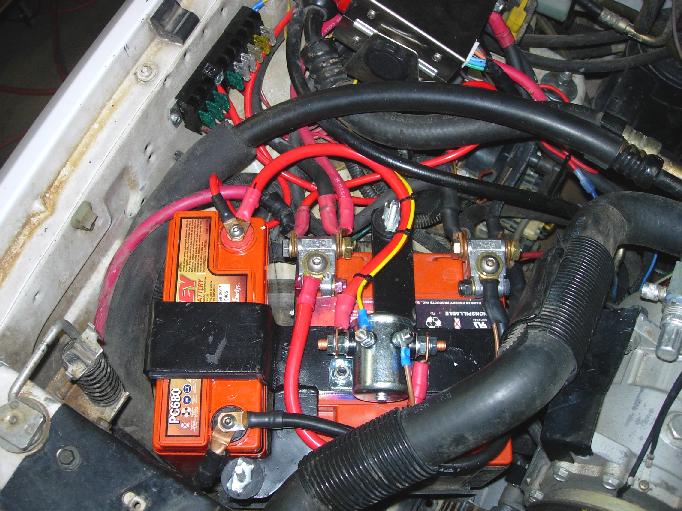There is a 925 and 680 Odyssey mounted in the stock tray. I had to cut out the end for the 925 so it could overlap about 1/2 inch. Then I made the hold down to retain the batteries in their spots without being able to move any closer to one another.
The tray is just there until I decide to build a new one. I broke the stock tray earlier this year when it just had the 925 on it.
Stuff crammed into that area.
The silver part on top of the batteries is a continous duty 100 (or 200 I can't remember which one I bought) relay. You can pick them up fairly cheap from RV stores. It connects the two batteries when the key is forward only.
The 9 bank fuse block is there to replace the original fusible links.
The silver box at the top of the picture is my welder.
There are wires for my winch, 2 ga. wires for the alternator (ground and charge), 2 ga. wire for the starter, 2 ga wires going to the frame and block, 4ga wire to connect the two batteries, 8 ga wire to go to the new 9 bank fuse block, 8 ga wire going to another set of relays on the other side for the air compressor, lights, and electric fan.
As for the Odyssey's I like them, but they do have some limits. The reserve time isn't the best, I found it doesn't really matter which battery you buy size gets the reserve. Deka (
http://www.eastpenn-deka.com/ ) makes some nice small case batteries that really like to dump juice and they are a little cheaper than the Odyssey's. We had a 325 CCA battery dump 625 on a 10 second pull. Again the reserve isn't the best. I was going to use them and see how it stood up to the Odyssey but I couldn't find one that would fit like the pic. They were either 1/2" too wide or 1/2" too thick.
Optima makes 6 volt versions of their 12 volt (exactly 1/2 of the 12). I used to run two of those under the back seat and I had plenty of reserve for my old Stereo and even ran on those when the main battery went bad. It would be easy to get an Odyssey to fit there also.


